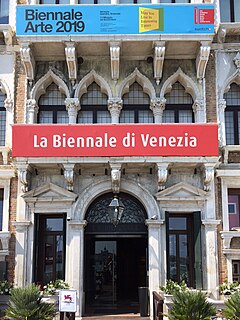
The Venice Biennale is an arts organization based in Venice and the name of the original and principal biennial exhibition the organization presents. The organization changed its name to the Biennale Foundation in 2009, while the exhibition is now called the Art Biennale to distinguish it from the organization and other exhibitions the Foundation organizes.

Biennale, Italian for "biennial" or "every other year", is any event that happens every two years. It is most commonly used within the art world to describe large-scale international contemporary art exhibitions. As such the term was popularised by Venice Biennale, which was first held in 1895. The phrase has since been used for other artistic events, such as the "Biennale de Paris", "Kochi-Muziris Biennale", or even as a portmanteau as with Berlinale and Viennale. "Biennale" is therefore used as a general term for other recurrent international events.
Rosa Martínez is an independent curator, art critic and international art advisor based in Barcelona, Spain.

Hans Ulrich Obrist is a Swiss art curator, critic and historian of art. He is artistic director at the Serpentine Galleries, London. Obrist is the author of The Interview Project, an extensive ongoing project of interviews. He is also co-editor of the Cahiers d'Art review.
Rachel Harrison is an American visual artist known for her sculpture, photography, and drawing. Her work often combines handmade forms with found objects or photographs, bringing art history, politics, and pop culture into dialogue with one another. She has been included in numerous exhibitions in Europe and the US, including the Venice Biennale, the Whitney Biennial and the Tate Triennial (2009). Her work is in the collections of major museums such as The Museum of Modern Art, New York; Metropolitan Museum of Art, New York; Hirshhorn Museum and Sculpture Garden, Washington, D.C.; and Tate Modern, London; among others. She lives and works in New York.
Rirkrit Tiravanija is a Thai contemporary artist residing in New York City, Berlin, and Chiangmai, Thailand. He was born in Buenos Aires, Argentina in 1961. His installations often take the form of stages or rooms for sharing meals, cooking, reading or playing music; architecture or structures for living and socializing are a core element in his work.

The Taipei Fine Arts Museum is a museum in Zhongshan District, Taipei, Taiwan. It is in the Taipei Expo Park. The museum first opened on August 8, 1983, at the former site of the United States Taiwan Defense Command. It was the first museum in Taiwan built for contemporary art exhibitions. The architecture is a local interpretation of the Japanese Metabolist Movement, and the building was designed by architect Kao Er-Pan.

Emily Jacir is a Palestinian artist and filmmaker.

Maria Lassnig was an Austrian artist known for her painted self-portraits and her theory of "body awareness". She was the first female artist to win the Grand Austrian State Prize in 1988 and was awarded the Austrian Decoration for Science and Art in 2005. Lassnig lived and taught in Vienna from 1980 until her death.

Franz West was an Austrian artist.

Manfred "KILI" Kielnhofer is an Austrian painter, sculptor, designer and photographer.
Nicholas Hlobo is a South African artist based in Johannesburg, South Africa. He was born in 1975 in Cape Town. He earned a Bachelor of Technology from Technikon Witwatersrand in 2002. He creates large sculptural works that are expansive masses which at once feel oozey, voluptuous and highly structured. The contrast of femininity and masculinity is created by his use of dissimilar materials such as rubber inner tubes, ribbon, organza, lace and found objects.

Jennifer Allora and Guillermo Calzadilla are a collaborative duo of visual artists who live and work in San Juan, Puerto Rico. They were the United States Representatives for the 2011 Venice Biennale, the 54th International Art Exhibition, in 2011.
Shary Boyle is a contemporary Canadian visual artist working in the mediums of sculpture, drawing, painting and performance art. She lives and works in Toronto.
The Berlin Biennale is a contemporary art exhibition, which has been held at various locations in Berlin, Germany, every two to three years since 1998. The curator or curators choose the artists who will participate. After the event became established, annual themes were introduced. The Biennale is now underwritten by the German government through the Kulturstiftung des Bundes, and is the second most important contemporary arts event in the country, after documenta. The Berlin Biennale was co-founded on 26 March 1996 by Klaus Biesenbach and a group of collectors as well as patrons of art. Biesenbach is also the founding director of KW Institute for Contemporary Art and currently serves as Director of MoMA PS1 and Chief Curator at Large at MoMA.
Ala Younis is a research-based artist and curator, based in Amman. Younis initiates journeys in archives and narratives, and reinterprets collective experiences that have collapsed into personal ones. Through research, she builds collections of objects, images, information, narratives, and notes on why/how people tell their stories. Her practice is based on found material, and on creating materials when they cannot be found or when they do not exist.

Ute Meta Bauer. She is an international curator, professor of contemporary art and the director of the Centre for Contemporary Art (CCA) in Singapore.
Natalie King is an Australian curator and writer working in Melbourne, Australia. She specializes in Australian and international programs for contemporary art and visual culture. This includes exhibitions, publications, workshops, lectures and cultural partnerships across contemporary art and indigenous culture.
The 51st Venice Biennale, held in 2005, was an exhibition of international contemporary art. The Venice Biennale takes place biennially in Venice, Italy. Prizewinners included Barbara Kruger, the French pavilion with Annette Messager, Thomas Schütte, and Regina José Galindo.
Alban Muja is a Kosovan contemporary artist and film-maker. In 2019 he represented Kosovo at the 58th Venice Biennale. In his work he is mostly influenced by the social, political and economical transformation processes in wider surrounding region, he investigates history and socio-political themes and links them to his position in Kosovo today. His works cover a wide range of media including video installation, films, drawings, paintings, photographs and performance which have been exhibited extensively in various exhibitions and festivals.